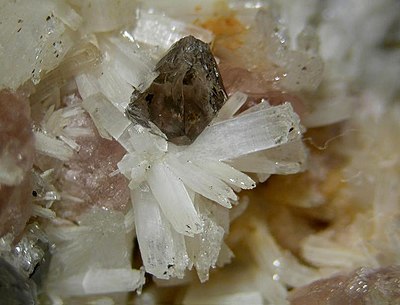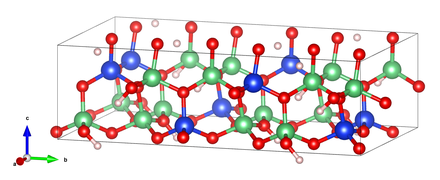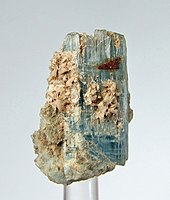Bertrandit
| Bertrandit | |
|---|---|
| White bertrandite crystals with smoky quartz from the Kara-Oba deposit in the Qaraghandy administrative region in Kazakhstan (field of view 10 mm) | |
| General and classification | |
| chemical formula |
|
|
Mineral class (and possibly department) |
Silicates and Germanates - group silicates |
|
System no. to Strunz and to Dana |
9.BD.05 ( 8th edition : VIII / B.07) 56.01.01.01 |
| Crystallographic Data | |
| Crystal system | orthorhombic |
| Crystal class ; symbol | orthorhombic-pyramidal; mm 2 |
| Space group | Cmc 2 1 (No. 36) |
| Lattice parameters | a = 8.72 Å ; b = 15.25 Å; c = 4.56 Å |
| Formula units | Z = 4 |
| Twinning | generally according to {011} or {021} |
| Physical Properties | |
| Mohs hardness | 6 to 7 |
| Density (g / cm 3 ) | measured: 2.59 to 2.60; calculated: [2.61] |
| Cleavage | completely after {001}; clearly after {100}, {010}, {110} |
| colour | colorless to pale yellow |
| Line color | White |
| transparency | transparent |
| shine | Glass luster, pearlescent luster according to {001} |
| Crystal optics | |
| Refractive indices |
n α = 1.591 n β = 1.605 n γ = 1.614 |
| Birefringence | δ = 0.023 |
| Optical character | biaxial negative |
| Axis angle | 2V = 73 ° to 81 ° (measured); 76 ° (calculated) |
| Other properties | |
| Special features | Pyroelectricity |
Bertrandit is a rarely occurring minerals from the mineral class of "silicates and germanates" with the chemical composition Be 4 [4] [(OH) 2 | Si 2 O 7 ], and thus chemically seen a beryllium - silicate with additional hydroxide . Structurally, Bertrandit belongs to the group silicates .
Bertrandite crystallizes in the orthorhombic crystal system and develops mostly needle-like to prismatic or tabular crystals and twins up to 5 cm in size, but is also found in the form of radial mineral aggregates or granular to coarse masses. The crystals are generally colorless and transparent and have a glass-like sheen on the surfaces . Due to multiple refraction due to lattice defects or polycrystalline formation, these can also appear white to pale yellow. However, its line color is always white.
Etymology and history
Bertrandite was first discovered in the Aplitic leuco granites near Petit-Port near Nantes in the Loire-Atlantique department in France. The first description was in 1883 by Augustin Alexis Damour , who named the mineral after the French mineralogist Émile Bertrand .
Type material of the mineral is kept at the École nationale supérieure des mines de Paris (English National School of Mines ) and in the Muséum national d'histoire naturelle (catalog no. 8374 ) in Paris , France.
classification
Already in the outdated 8th edition of the mineral classification according to Strunz , the Bertrandite belonged to the mineral class of the "silicates and germanates" and there to the department of the "group silicates (sorosilicates)" (with anions foreign to the tetrahedron ), where together with hemimorphite and clinoedrite it belonged to the "hemimorphite- Klinoedrit Group "with the system no. VIII / B.07 .
In the last revised and updated Lapis mineral directory by Stefan Weiß in 2018 , which, out of consideration for private collectors and institutional collections, is still based on this old form of Karl Hugo Strunz's system , the mineral was given the system and mineral number. VIII / C.07-10 . In the "Lapis system" this also corresponds to the division of "group silicates" ([Si 2 O 7 ] 6- , with non-tetrahedral anions (O, OH, F)), where Bertrandite, together with hemimorphite and junitoite, is an independent but unnamed Group forms.
The 9th edition of Strunz's mineral systematics , which has been in effect since 2001 and was updated by the International Mineralogical Association (IMA) until 2009, also classifies Bertrandite in the group of "group silicates". However, this is further subdivided according to the structure of the groups, the possible presence of additional anions and the coordination of the cations involved . The mineral is therefore in accordance with its structure and its composition in the subsection “Si 2 O 7 groups with additional anions; To find cations in tetrahedral [4] and / or other coordination ”, where it is the only member of the unnamed group 9.BD.05 .
The systematics of minerals according to Dana , which is mainly used in the English-speaking area , also assigns Bertrandite to the class of "silicates and Germanates", but there in the more finely subdivided division of " group silicates: Si 2 O 7 groups and O, OH, F and H 2 O “a. Here he is to be found as the only member of the unnamed group 56.01.01 within the subdivision “Group silicates: Si 2 O 7 groups and O, OH, F and H 2 O with cations in [4] coordination”.
Chemism
The idealized, theoretical composition of bertrandite (Be 4 [4] [(OH) 2 | Si 2 O 7 ]) consists of 15.13% beryllium (Be), 23.58% silicon (Si), 60.44% oxygen (O) and 0.85% hydrogen (H). The mineral occurs mainly in pure formula. Aluminum as a representative of silicon could only be detected in traces.
Crystal structure
Bertrandite crystallizes orthorhombically in the space group Cmc 2 1 (space group no. 36) with the lattice parameters a = 8.72 Å ; b = 15.25 Å and c = 4.56 Å and 4 formula units per unit cell .
The crystal structure of Bertrandit consists of Si 2 O 7 groups, which are connected to form wavy chains of tetrahedra and form a framework with assemblies of [O 3 BeOHBeO 3 ] 2 parallel [100]. The structure can alternatively be described as a weakly deformed, hexagonal closest packing of O 2+ and OH - ions with hexagonal planes parallel (100), in which 1/3 of the tetrahedral gaps are occupied by Be 2+ and Si 4+ .
- Crystal structure of Bertrandit as a "ball-and-stick model"
properties
morphology
Bertrandite typically develops small, tabular crystals with the tabular surfaces perpendicular to the c-axis as well as tetrahedral and clearly hemimorphic crystals. Using mineral samples from the Cairngorm Mountains in northeast Scotland, WC Morgan identified predominant crystal faces according to {100}, {010} and {001} with occasional narrow faces according to {110}, {130} and {011}.
Heart-shaped crystal twins with the twin planes according to {011} or {021} and V-shaped twins that cross at angles of about 60 ± and 120 ± are also known.
Physical Properties
The mineral shows perfect cleavage parallel to the surfaces along the c-axis {001}. These cleavage surfaces also show a pearly shine. There is at least a clear cleavage parallel to the surfaces {100}, {010} and {110}.
The mineral is pyroelectric , i.e. it reacts to periodic changes in temperature with charge separation. The polar axis is perpendicular to the surface of the table.
Modifications and varieties
Apart from the orthorhombic crystallizing Bertrandite, no further modification of the compound Be 4 Si 2 O 7 (OH) 2 is known.
The only known variety of Bertrandit so far is the so-called "Gel-Bertrandit", a glass-like, colloidal form of Bertrandit with a light purple color. Gel-Bertrandit was first discovered and described in 1957 by E. I. Semenov together with Sphaerobertrandit in the Lowosero-Tundra massif on the Russian Kola Peninsula .
Education and Locations
Bertrandite forms as an accessory component in volcanic rocks with a medium ( andesite ) to high ( rhyolite ) content of silicon dioxide (SiO 2 ), such as those found in the Sierra de Cartagena in Spain . It often arises as a secondary decomposition product of beryl in the hydrothermal post-phase of pegmatites such as in the Iveland district in the Norwegian province of Aust-Agder or in the Spitzkoppe ( Spitzkopje ) area in Namibia, and as a displacement product accompanied by aegirine , riebeckite and phenakite in the Fenite zones of alkaline rocks such as in Eastern Siberia . Rarely Bertrandit also comes in tin ore - deposits before.
Large deposits are formed by hydrothermal infiltration (infiltration and storage of solutions or dissolved substances in rock) in decomposed Rhyolith- Tuff where Bertrandit usually associated with Adular , fluorite , aragonite , calcite , kaolinite , the muscovite - variety sericite and various iron ores found . Well-known sites here include Chihuahua in Mexico and Spor Mountain in the Thomas Range in Juab County in the US state of Utah.
In the United States, where the mineral is mainly mined as beryllium ore, other deposits include the Grover Mine in Clear Creek County and the Lake George area in Park County of Colorado, as well as several quarries near Auburn (Pulsifer Quarry) and Greenwood ( Hayes Ledge Quarries) known in Maine.
It can also be found as a crack filling in granites and associated pegmatites as well as in miarolitic cavities in old men . Furthermore, depending on the location, other parageneses such as herderite , quartz and tourmaline were observed.
Around 700 Bertrandit sites have been documented worldwide to date. In addition to its type locality Petit-Port and the nearby Barbin quarry near Nantes , the mineral occurred in the Pays de la Loire region at La Chapelle-sur-Erdre . Other well-known sites in France are in the Massif de la Lauzière in the Savoy (Auvergne-Rhône-Alpes), in the La Vilatte quarries near Chanteloube in the Haute-Vienne (Nouvelle-Aquitaine) department and in a few places in Brittany and Grand Est .
In Germany, the mineral is known from the Rappenloch and Teufelsgrund pits near Eisenbach in the Breisgau-Hochschwarzwald district , a porphyry quarry near Detzeln and various locations near Hornberg in Baden-Württemberg; from several quarries in Lower Bavaria , Upper and Lower Franconia in Bavaria; from various pits and quarries in the Saxon Erzgebirgskreis as well as from the Birkenkopf near Mensfelden in Hesse and from the Henneberg quarry near Weitisberga in Thuringia.
In Austria, Bertrandit has so far mainly been found in various valleys of the Goldberg Group in Carinthia, in the vicinity of the municipality of Spitz (Mieslingtal, Radlbach) in Wachau and in some quarries in the Waldviertel in Lower Austria, in many places in the Gastein Valley , Habach Valley and Rauris Valley in the Salzburg region become.
In Switzerland, the mineral was found on the Forno and Albigna glaciers in the canton of Graubünden; in several places in the Gotthard massif (Airolo, Carona, Fontana); at Brunnenstöckli in the Voralptal (Göschener Tal) and at Deieren on the Furkapass in the canton of Uri and at several points in the Binntal (Albrunhorn-Turbhorn, Chummibort, Kriegalp) in the canton of Valais.
Known by exceptional Bertranditfunden are also the community Conselheiro Pena in the Brazilian state of Minas Gerais , where tabular crystals have been discovered cm with diameters of up to 5 and the Kounradmassiv near Balkhash in Kazakhstan with crystal findings of up to 3 cm size.
Other locations include Argentina, Australia, Brazil, China, Finland, Italy, Japan, Canada, Kazakhstan, Namibia, Norway, Portugal, Russia, Sweden, Slovakia, South Africa, Spain, the Czech Republic and the United Kingdom (UK).
Bertrandite on aquamarine from Mount Antero , Chaffee County , Colorado, USA (size: 2.6 cm 1.7 cm 1.3 cm)
Sheaf-shaped mineral aggregate made of tabular Bertrandite crystals from the Golconda pegmatite near Governador Valadares , Brazil
(size: 5.3 cm × 4.1 cm × 2.7 cm)Colorless, tabular Bertranditkristalle from the deposit Kara-Oba, Betpakdala Desert, Karaganda , Kazakhstan
Fine white bertrandite crystals (thickness approx. 1 mm) with brown cassiterite and quartz (center left) from Mount Bischoff , Tasmania, Australia
use
In addition to beryl, bertrandite is the most important ore for the extraction of beryllium with a beryllium content of around 15% in its pure form (corresponds to 42% BeO) .
See also
literature
- AA Damour: Note et analyze sur le nouveau miné des environs de Nantes . In: Bulletin de la Société Minéralogique de France . tape 6 , 1883, p. 252–254 (French, rruff.info [PDF; 124 kB ; accessed on July 21, 2019]).
- Richard V. Gaines, H. Catherine W. Skinner, Eugene E. Foord, Brian Mason , Abraham Rosenzweig: Dana's New Mineralogy . 8th edition. John Wiley & Sons, New York et al. 1997, ISBN 0-471-19310-0 , pp. 1149-1150 .
Web links
- Mineral Atlas: Bertrandit (Wiki)
- Bertrandite search results. In: rruff.info. Database of Raman spectroscopy, X-ray diffraction and chemistry of minerals (RRUFF), accessed on July 21, 2019 .
- American-Mineralogist-Crystal-Structure-Database - Bertrandite. In: rruff.geo.arizona.edu. Retrieved July 21, 2019 .
Individual evidence
- ↑ Malcolm Back, William D. Birch, Michel Blondieau and others: The New IMA List of Minerals - A Work in Progress - Updated: March 2020. (PDF 1729 kB) In: cnmnc.main.jp. IMA / CNMNC, Marco Pasero, March 2020, accessed on March 21, 2020 .
- ↑ a b c d e f Hugo Strunz , Ernest H. Nickel : Strunz Mineralogical Tables. Chemical-structural Mineral Classification System . 9th edition. E. Schweizerbart'sche Verlagbuchhandlung (Nägele and Obermiller), Stuttgart 2001, ISBN 3-510-65188-X , p. 573 (English).
- ↑ a b c David Barthelmy: Bertrandite Mineral Data. In: webmineral.com. Retrieved July 21, 2019 .
- ↑ a b c d e f g h i j Bertrandite . In: John W. Anthony, Richard A. Bideaux, Kenneth W. Bladh, Monte C. Nichols (Eds.): Handbook of Mineralogy, Mineralogical Society of America . 2001 (English, handbookofmineralogy.org [PDF; 71 kB ; accessed on July 21, 2019]).
- ↑ a b c d e Bertrandite. In: mindat.org. Hudson Institute of Mineralogy, accessed July 21, 2019 .
- ↑ Picture example for yellow colored Bertrandite. In: mindat.org. Hudson Institute of Mineralogy, accessed July 21, 2019 .
- ^ Catalog of Type Mineral Specimens - Bertrandite. (PDF 122 kB) In: docs.wixstatic.com. Commission on Museums (IMA), December 12, 2018, accessed July 21, 2019 .
- ↑ Stefan Weiß: The large Lapis mineral directory. All minerals from A - Z and their properties. Status 03/2018 . 7th, completely revised and supplemented edition. Weise, Munich 2018, ISBN 978-3-921656-83-9 .
- ↑ Ernest H. Nickel, Monte C. Nichols: IMA / CNMNC List of Minerals 2009. (PDF 1703 kB) In: cnmnc.main.jp. IMA / CNMNC, January 2009, accessed March 21, 2020 .
- ^ A b c d Helmut Schrätze , Karl-Ludwig Weiner : Mineralogie. A textbook on a systematic basis . de Gruyter, Berlin; New York 1981, ISBN 3-11-006823-0 , pp. 712-714 .
- ^ WC Morgan: Genthelvite and bertrandite from the Cairngorm Mountains, Scotland . In: Mineralogical Magazine . tape 36 , 1967, p. 60–63 (English, rruff.info [PDF; 174 kB ; accessed on August 13, 2019]).
- ^ Friedrich Klockmann : Klockmanns textbook of mineralogy . Ed .: Paul Ramdohr , Hugo Strunz . 16th edition. Enke, Stuttgart 1978, ISBN 3-432-82986-8 , pp. 690 (first edition: 1891).
- ↑ Michael Fleischer : New Mineral Names . In: American Mineralogist . tape 43 , no. 11-12 , 1958, pp. 1219 (English, rruff.info [PDF; 461 kB ; accessed on March 21, 2020]).
- ↑ Hanns W. Maull: Strategic Raw Materials: Risks for the Economic Security of the West (= International Politics and Economy . No. 53 ). R. Oldenbourg Verlag, Munich 1988, ISBN 3-486-54391-1 , p. 156 ( limited preview in Google Book Search - accessed via De Gruyter Online).
- ↑ a b List of locations for Bertrandite in the Mineralienatlas and Mindat , accessed on March 21, 2020.
- ↑ Localities for Bertrandite. In: mindat.org. Hudson Institute of Mineralogy, accessed August 13, 2019 .
- ↑ Petr Korbel, Milan Novák: Mineral Encyclopedia (= Dörfler Natur ). Edition Dörfler im Nebel-Verlag, Eggolsheim 2002, ISBN 978-3-89555-076-8 , p. 212 .








